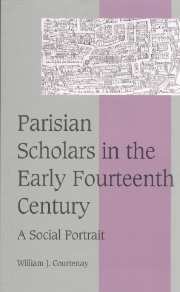Book contents
- Frontmatter
- Contents
- List of maps and figures
- Preface
- List of abbreviations
- INTRODUCTION: PARIS IN 1329
- Part I The recovery and context of a document
- Part II A window on a lost world
- 4 ACADEMIC SPACE: THE TOPOGRAPHY OF THE UNIVERSITY COMMUNITY
- 5 LODGING AND RESIDENTIAL PATTERNS
- 6 THE SOCIOLOGY OF THE UNIVERSITY COMMUNITY
- 7 THE GEOGRAPHICAL ORIGINS OF THE UNIVERSITY COMMUNITY
- CONCLUSION
- Part III Biographical register
- Select bibliography
- Index of persons and places
- Subject index
- Cambridge Studies in Medieval Life and Thought Fourth series
CONCLUSION
Published online by Cambridge University Press: 17 August 2009
- Frontmatter
- Contents
- List of maps and figures
- Preface
- List of abbreviations
- INTRODUCTION: PARIS IN 1329
- Part I The recovery and context of a document
- Part II A window on a lost world
- 4 ACADEMIC SPACE: THE TOPOGRAPHY OF THE UNIVERSITY COMMUNITY
- 5 LODGING AND RESIDENTIAL PATTERNS
- 6 THE SOCIOLOGY OF THE UNIVERSITY COMMUNITY
- 7 THE GEOGRAPHICAL ORIGINS OF THE UNIVERSITY COMMUNITY
- CONCLUSION
- Part III Biographical register
- Select bibliography
- Index of persons and places
- Subject index
- Cambridge Studies in Medieval Life and Thought Fourth series
Summary
The preceding chapters, along with the edition of the computus of 1329–30 and the biographical register, contribute to the understanding of the university of Paris in the early fourteenth century on several different levels. Foremost is the textual contribution. The computus, as reconstructed and reedited (Appendix I), places at the service of future scholars one of the most remarkable and useful documents for the history of Paris and its university to survive from the high and late Middle Ages. The computus provides a more precise sense of the topographical relationship between the university community and the rest of Paris than almost any other document. And because of its potential for economic, geographical, and biographical analysis, it is also an important document for the history of medieval universities in general. The misarrangement and occasional mistranscription of the document as previously edited obscured its significance and prevented it from becoming the object of study that it merits. While it would be naive to assume that further refinements in transcription are not possible, this edition should provide furture generations with a major prosopographical source for the medieval university of Paris.
The biographical register (Part III) – the second most important contribution of this book – will (it is hoped) eventually be incorporated into a more complete biographical register of the medieval university of Paris, similar to the biographical registers on Oxford and Cambridge produced by A. B. Emden.
- Type
- Chapter
- Information
- Parisian Scholars in the Early Fourteenth CenturyA Social Portrait, pp. 124 - 126Publisher: Cambridge University PressPrint publication year: 1999

